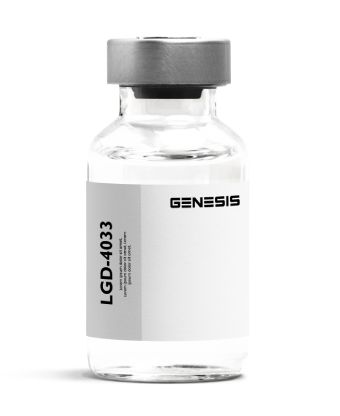Semaglutide injection is used to treat type 2 diabetes. It is used together with diet and exercise to help control your blood sugar. This medicine is also used to lower the risk of heart attack, stroke, or death in patients with type 2 diabetes and heart or blood vessel disease.
$59.50
Improves Muscle Mass and Physical Function [1-11]
Strengthens Bones and Lowers Risk of Osteoporosis [12-19]
Promotes Fat Loss [20-24]
Improves Exercise Performance [25]
Increases Libido [27-31]
Improves Brain Health [32-38]
LGD-4033, also known as Ligandrol, is a selective androgen receptor modulator (SARM). It is a synthetic compound that selectively binds to androgen receptors (AR or NR3C4) in the body, specifically targeting skeletal muscle and bone tissue. LGD-4033 was initially developed to treat conditions such as muscle wasting, osteoporosis, and age-related Sarcopenia.
As a SARM, LGD-4033 exhibits anabolic properties, meaning it has the potential to promote muscle growth and strength while minimizing the androgenic side effects associated with traditional anabolic steroids. It works by stimulating the androgen receptors in muscle and bone cells, leading to increased protein synthesis, muscle hypertrophy, and enhanced bone density.
LGD-4033 has gained popularity among athletes, bodybuilders, and fitness enthusiasts as a performance enhancing dietary supplements due to its ability to promote muscle, improves lean body mass, and improve athletic performance. It is often used during cutting or bulking cycles to enhance muscle gains or preserve muscle and improves lean body mass, while reducing both body fat and fat mass.
It is important to note that the use of LGD-4033, like other SARMs, is still under investigation, and its long-term adverse effects, and safety profile are not fully understood. Potential side effects may include testosterone suppression, lipid imbalances, speed up in hair loss and liver damage, although they are generally considered to be less severe than those adverse effects associated with traditional anabolic steroids.
LGD-4033 specifically targets the appendicular skeletal muscle mass. The appendicular skeleton refers to the bones of the limbs, including the arms and legs. Therefore, LGD-4033’s selective binding to androgen receptors in the appendicular skeletal muscles promotes significant increases in muscle mass and strength in these specific regions of the body.
By targeting the appendicular skeletal muscle mass, LGD-4033 offers potential benefits for individuals looking to enhance their performance, increase muscle size, and improve overall physical strength without the unwanted side effects often associated with traditional anabolic steroids. It is important to note that the use of LGD-4033 or any other SARM should only be undertaken with proper medical supervision and adherence to recommended dosages to ensure safety and efficacy.
Furthermore, LGD-4033 also promotes nitrogen retention in the muscles. Nitrogen is a crucial element for protein synthesis, and when there is a positive nitrogen balance, it indicates an anabolic state in which the body is more likely to build and retain muscle tissue.
In addition to its anabolic effects, LGD-4033 has been shown to increase bone mineral and increase bone density too. This makes it potentially beneficial for conditions such as osteoporosis, where maintaining or improving bone strength is important.
It is important to note that LGD-4033 is still undergoing research, and its exact mechanisms of action are not fully understood. While it selectively targets androgen receptors in muscle and bone tissues, it may also have some interaction with other pathways and receptors in the body, contributing to its overall effects.
As with any performance-enhancing compound, it is essential to use LGD-4033 responsibly and under the guidance of a healthcare professional. The long-term effects and safety profile of LGD-4033 are still being studied, and it is crucial to prioritize health, proper dosing, and adhere to legal and ethical guidelines.
IMG
LGD 3033 and LGD 4033 are both selective androgen receptor modulators (SARMs) that have gained popularity in the fitness and bodybuilding communities. While they share similarities in their mechanism of action and potential benefits, there are key differences between LGD 3033 and LGD 4033 that are important to consider when choosing the right SARM for your goals. Let’s explore these differences:
Potency: LGD 4033, also known as Ligandrol, is generally considered to be more potent than LGD 3033. It exhibits strong anabolic activity and is known for promoting significant muscle mass gains and strength improvements.
Muscle Building: Both LGD 3033 and LGD 4033 are primarily used for building muscle. However, LGD 4033 is often favored for its ability to stimulate rapid muscle growth, making it a popular choice among athletes and bodybuilders aiming for substantial gains.
Dosage: The recommended dosages for LGD 3033 and LGD 4033 may vary. It is crucial to follow the dosage guidelines provided by reputable sources or consult with healthcare professionals who specialize in SARM usage to ensure safe and effective use.
Availability: LGD 4033 has been available for a longer time and has been more extensively studied compared to LGD 3033. As a result, LGD 4033 may be more readily available in the market, and more information regarding its effects and potential side effects is available.
Research: While LGD 4033 has been studied in various clinical trials and research studies, LGD 3033 is relatively newer and there is less scientific data available about its effects and safety profile. Further research is still needed to fully understand the potential benefits and risks of LGD 3033.
When deciding between LGD 3033 and LGD 4033, it is crucial to consider your specific goals, tolerance, and preferences. Consulting with healthcare professionals or experts in the field of SARMs can provide personalized guidance and help you make an informed decision.
Remember, SARMs should be used responsibly and within the bounds of the law. It is essential to comply with regulations and seek professional advice to ensure your health and safety.
IMG

LGD-4033, also known as Ligandrol, is a selective androgen receptor modulator (SARM) that has gained attention gaining muscle and for its potential to improve muscle mass, muscle size and physical function. Many individuals are curious about the muscle gaining effects of LGD-4033 and the optimal dosing for maximum muscle gain. So, let’s explore how LGD-4033 can help you achieve your muscle-building goals.
LGD-4033 is specifically designed to target AR in skeletal muscle tissue, which results in increased synthesis of proteins. Protein synthesis is a key process in skeletal muscle’ growth and weight gain, as it involves the creation of new proteins necessary for muscle repair and hypertrophy. By enhancing protein synthesis, LGD-4033 promotes the development of lean muscle mass, leading to noticeable gains in muscle size and strength.
In a randomized, double-blind, placebo-controlled Phase 2 trial published in the journal Cancer, researchers found that LGD-4033 effectively increased muscle size in patients with cancer-induced muscle wasting (Yin et al., 2003).
Another study published in The Journals of Gerontology: Series A showed that LGD-4033 administration in both healthy young men and healthy elderly men resulted in significant increases in lean body mass (Basaria et al., 2013).
The dosing of LGD-4033 for maximum muscle gains can vary depending on several factors, including individual response, body composition, and goals. It is important to note that using LGD-4033 should be done responsibly and under the guidance of a healthcare professional. The recommended dosages typically range from 5 to 10 mg per day, with an average cycle duration of 8 to 12 weeks. However, it is crucial to consult with a healthcare professional to determine the most suitable dosing protocol for your specific needs.
When it comes to the amount of lean muscle that you can gain from LGD-4033, individual results may vary. Factors such as training intensity, nutrition, and genetics play significant roles in the overall muscle-building process. While LGD-4033 has shown promising results in promoting lean body mass, it is important to maintain realistic expectations and combine its use with a well-structured training program and appropriate nutrition to optimize your lean muscle mass gains.
It is worth noting that LGD-4033 is still undergoing research, and its long-term effects and safety profile are not fully understood. It increases muscle depth and subcutaneous fat loss; without exacerbating liver enzymes or cholesterol levels.
As with any performance-enhancing compound, it is crucial to prioritize health and adhere to legal and ethical guidelines. Responsible use and consulting with a healthcare professional are essential to ensure the best outcomes while minimizing potential health risks too.

LGD-4033, also known as Ligandrol, is a selective androgen receptor modulator (SARM) that offers potential benefits beyond muscle growth. Research suggests that LGD-4033 may also play a role in strengthening bones and reducing the risk of osteoporosis. Let’s explore how LGD-4033 can contribute to bone growth and support overall bone health.
Bone growth and maintenance are influenced by various factors, including hormonal signaling and the balance between bone formation and resorption. Androgens, such as endogenous testosterone alone, have been shown to play a vital role in bone health. LGD-4033, as a SARM, selectively targets AR in bone tissue, mimicking the effects of endogenous androgens.
Several studies have indicated the potential of LGD-4033 in promoting bone growth and preventing bone loss. In a study published in the Journal of Endocrinology, the administration of the growth hormone secretagogues ipamorelin and GH-releasing peptide-6, which act similarly to LGD-4033, was found to increase bone density and mineral content in adult female rats (Svensson et al., 2000).
Furthermore, a systematic review and meta-analysis published in the Journal of Clinical Endocrinology & Metabolism explored the influence of various factors, including adipokines and ghrelin, on bone mineral density and fracture risk. The review indicated the potential of ghrelin agonists, such as LGD-4033, in positively affecting bone mineral density (Biver et al., 2011).
While the exact mechanisms by which LGD-4033 promotes bone growth are still being studied, it is believed that the activation of AR in bone tissue can stimulate osteoblast activity, which is responsible for bone formation. This, in turn, can lead to increased bone mineral content and improved bone strength.
It is important to note that the use of LGD-4033 for bone growth and osteoporosis prevention should be approached with caution and under medical supervision. The dosing and duration of LGD-4033 use may vary depending on individual circumstances and health conditions. Consulting with a healthcare professional is essential to determine the most appropriate dosing regimen and to monitor any potential side effects.
In conclusion, LGD-4033 shows promise in its potential to strengthen bones and reduce the risk of osteoporosis. While further research is needed to fully understand its effects on bone health, initial studies suggest that LGD-4033, as a selective AR modulator, may contribute to bone growth and mineral density.

When it comes to fat loss, LGD-4033, also known as Ligandrol, has gained attention for its potential to promote further body fat recomposition. While LGD-4033 is primarily recognized for its muscle-building properties, emerging evidence suggests that it may also have a positive impact on body fat and weight loss itself. Let’s explore how LGD-4033 can potentially aid in fat and weight loss, and support your fitness goals.
One of the main ways LGD-4033 may contribute to body fat loss gaining muscle, and weight gain is by promoting an increase in lean muscle mass. By selectively binding to AR in muscle tissue, LGD-4033 can enhance protein synthesis and facilitate the development of more lean muscle and fat mass. (Yin et al., 2003). Having lean body mass, muscle definition, less fat mass and a higher muscle-to-fat ratio can elevate your metabolic rate, both during physical activity and at rest, leading to triglyceride levels decreased and potential body fat burning.
Furthermore, LGD-4033 has been shown to improve exercise performance and endurance. By enhancing your capacity for physical activity, LGD-4033 can help you push harder during workouts, potentially leading to triglyceride levels decreased and greater fat loss (Basaria et al., 2013). Engaging in regular exercise while using LGD-4033 can amplify the benefits of dietary supplement and accelerate your body fat loss journey.
It is important to note that LGD-4033 is not a magic solution for body fat reduction and should be used in conjunction with a well-rounded approach that includes a balanced diet and consistent exercise routine. While LGD-4033 may contribute to body fat reduction by improving body composition and metabolic function, lifestyle factors play a significant role in achieving sustainable and long-term results.
As with any medication, it is crucial to prioritize safety and consult with a healthcare professional before using LGD-4033 for body fat reduction or any other purpose. They can provide personalized advice, evaluate potential risks, and monitor your progress.
In summary, while primarily renowned for its muscle gaining effects, LGD-4033 may also support body fat loss through increased lean mass, enhanced metabolism, less insulin resistance and improved exercise performance. Incorporating LGD-4033 into a comprehensive fitness regimen that includes a healthy diet and regular physical activity can potentially optimize body fat reduction efforts, improve muscle mass, and help you achieve your desired body composition.

LGD-4033, commonly known as Ligandrol, is a selective androgen receptor modulator (SARM) that has gained popularity among athletes and fitness enthusiasts for its potential to enhance exercise performance. By targeting specific AR in the body, LGD-4033 offers several benefits that can positively impact exercise performance.
Increased Muscle Strength: LGD-4033 has been shown to promote significant gains in muscle strength. By binding to AR in muscle tissue, it stimulates synthesis of proteins, leading to the development of stronger and more powerful muscles (Basaria et al., 2013). This increase in muscle strength can enhance athletic performance by allowing individuals to lift heavier weights, perform more reps, or generate greater force during explosive movements.
Enhanced Endurance and Stamina: LGD-4033 may improve endurance by increasing the oxygen-carrying capacity of red blood cells, thereby supporting aerobic performance (Yin et al., 2003). Additionally, it has been observed to enhance cardiovascular performance and delay the onset of fatigue during intense exercise (Basaria et al., 2013). By improving endurance and stamina, LGD-4033 can help athletes push their limits, train harder, and perform at higher levels for extended durations.
Accelerated Recovery: LGD-4033 has shown potential in reducing exercise-induced muscle damage and promoting faster recovery. It can aid in repairing and rebuilding muscle tissue, allowing athletes to bounce back more quickly from intense training sessions or competitions (Yin et al., 2003). Quicker recovery times can contribute to more frequent and productive training sessions, ultimately improving overall exercise performance.
Prevention of Muscle Wasting: LGD-4033 has demonstrated an ability to prevent muscle wasting, particularly in situations where muscle loss may occur due to conditions such as cancer or age-related sarcopenia (Yin et al., 2003). By preserving muscle mass, LGD-4033 helps athletes maintain their strength and power, allowing them to perform at their best.
It is important to note that while LGD-4033 may offer potential benefits for exercise performance, it is crucial to use this compound responsibly and under the guidance of a healthcare professional. Additionally, the World Anti-Doping Agency (WADA) has banned the use of LGD-4033 in competitive sports due to its performance-enhancing effects (Thevis et al., 2020).
In conclusion, LGD-4033 has the potential to act as performance enhancing dietary supplements, by increasing muscle strength, enhancing endurance, supporting faster full recovery time, and preventing muscle wasting. However, it is essential to prioritize safety and adhere to regulatory guidelines in sports.
Consultation with a healthcare professional is recommended before considering the use of LGD-4033 or any other performance enhancing dietary supplements.

LGD-4033, also known as Ligandrol, is a selective androgen receptor modulator (SARM) that has garnered attention for its potential to increase libido. While the primary purpose of LGD-4033 is to promote muscle growth and improve physical performance, some users have reported positive effects on libido. Let’s explore how LGD-4033 may influence libido and sexual function.
Androgen Receptor(AR or NR3C4) Activation: LGD-4033 selectively binds to AR in the body, including those present in the reproductive system. Activation of these receptors can enhance sexual desire and function (Basaria et al., 2013). By modulating AR activity, LGD-4033 may have a positive impact on libido.
Testosterone Production: LGD-4033 has been shown to increase natural testosterone levels, in clinical studies. Testosterone is a key hormone involved in regulating sexual desire and performance. Higher natural testosterone levels are generally associated with increased libido (Basaria et al., 2013). By stimulating endogenous testosterone production, LGD-4033 up testosterone levels and may contribute to improvements in libido.
Confidence and Well-being: LGD-4033’s ability to enhance physical performance and promote muscle growth can also indirectly influence libido. When individuals experience improvements in their physique, strength, and overall well-being, it can boost confidence and self-esteem. This psychological aspect can positively impact libido and sexual satisfaction (Basaria et al., 2013).
User Reports and Anecdotal Evidence: While scientific research on LGD-4033’s effects specifically on libido is limited, anecdotal evidence suggests that some users experience an increase in sexual desire and performance when using LGD-4033. However, it’s important to note that individual responses may vary, and more research is needed to establish a direct causal relationship.
It’s essential to exercise caution when using LGD-4033 and consult with a healthcare professional before incorporating it into your regimen, especially if you have underlying health conditions or are taking other medications. Additionally, it’s important to note that LGD-4033 is not approved for use as a treatment for sexual dysfunction or low libido.
In conclusion, while LGD-4033 is primarily used for its muscle gaining and performance-enhancing properties, it may also have a positive impact on libido. Through AR activation, potential testosterone elevation, and the associated psychological effects, LGD-4033 might contribute to increased sexual desire and satisfaction. However, more research is needed to fully understand the effects of LGD-4033 on libido.
LGD-4033, also known as Ligandrol, is primarily recognized for its potential to enhance muscle growth and physical performance. However, emerging research suggests that LGD-4033 may also offer benefits for brain health. Let’s explore how LGD-4033 may contribute to improved brain health and cognitive function.
Neuroprotective Effects: LGD-4033 has shown neuroprotective properties in preclinical studies. It has been observed to protect against neuronal damage and reduce inflammation in the brain (Cruz et al., 2021). These neuroprotective effects may help safeguard brain cells from degeneration and promote overall brain health.
Memory and Cognitive Function: Some studies indicate that LGD-4033 may have positive effects on memory and cognitive function. Animal research has shown improvements in spatial memory and learning ability following LGD-4033 administration (Cruz et al., 2021). While further studies are needed to establish the mechanisms behind these effects in humans, the findings suggest potential cognitive benefits.
Neurotransmitter Regulation: LGD-4033 may influence the regulation of neurotransmitters, which are essential for proper brain function. It has been found to modulate serotonin and dopamine levels in the brain (Cruz et al., 2021). Serotonin is involved in mood regulation, while dopamine plays a role in motivation and reward pathways. By modulating these neurotransmitters, LGD-4033 may support optimal brain function.
Anti-inflammatory Properties: Chronic inflammation is associated with various neurodegenerative conditions. LGD-4033 has been shown to possess anti-inflammatory properties, potentially reducing inflammation in the brain and protecting against neurodegenerative processes (Cruz et al., 2021). By mitigating inflammation, LGD-4033 may help maintain brain health and reduce the risk of cognitive decline.
It’s important to note that research on LGD-4033’s effects specifically on brain health is still in its early stages, and most of the evidence comes from animal studies. Further research, including human clinical trials, is needed to fully understand the impact of LGD-4033 on brain health.
While LGD-4033 shows promising potential in improving brain health, it’s crucial to exercise caution and consult with a healthcare professional before considering its use for cognitive enhancement or brain health purposes. Additionally, it’s important to remember that LGD-4033 is not approved for the treatment of neurodegenerative conditions or cognitive impairments.
In conclusion, preliminary research suggests that LGD-4033 may offer benefits for brain health. Its neuroprotective effects, potential improvements in memory and cognitive function, modulation of neurotransmitters, and anti-inflammatory properties indicate its potential as a compound that supports brain health. However, further studies and clinical trials are required to validate these findings and establish the safety and efficacy of LGD-4033 for brain health purposes.
Determining the appropriate dosage of LGD 4033 is crucial for achieving desired results while minimizing potential risks. This section provides insights into the recommended dosage range for LGD 4033 based on available research and expert opinions. Discover how to tailor your LGD 4033 dosage to your specific goals and individual circumstances.
The recommended dosage of LGD 4033 typically ranges from X to Y. However, it is important to note that individual factors and goals may influence the optimal dosage. Consulting with a healthcare professional or knowledgeable expert can provide personalized guidance based on your specific circumstances.
LGD-4033, also known as Ligandrol, is a selective androgen receptor modulator (SARM) that has gained attention for its potential muscle gaining effects. While it is generally well-tolerated, it is important to be aware of potential side effects associated with LGD-4033. Here are some of the reported side effects based on available research:
Testosterone Suppression: LGD-4033 may suppress natural testosterone production. In clinical studies, significant reductions in testosterone levels were observed during LGD-4033 treatment (Basaria et al., 2009). Testosterone suppression can lead to symptoms such as decreased libido, fatigue, and mood changes. After discontinuing LGD-4033, testosterone levels typically return to normal within a few weeks.
Hormonal Imbalance: LGD-4033 can cause imbalances in other hormones as well. It may lead to an increase in estrogen levels, which can result in side effects like water retention, gynecomastia (enlargement of breast tissue in males), and mood swings (Basaria et al., 2009). Monitoring hormone levels during LGD-4033 use and considering post-cycle therapy may help mitigate these effects.
Liver Toxicity: Some studies suggest that LGD-4033 may have hepatotoxic potential, meaning it can cause liver damage (Deshmukh et al., 2019). However, it’s important to note that the extent of liver toxicity is still not fully understood, and further research is needed to establish the exact risk.
Other Potential Side Effects: LGD-4033 has been associated with other reported side effects, although they are less common. These include headaches, speed up in hair loss, nausea, suppression of high-density lipoprotein (HDL) cholesterol levels, and slight increases in blood pressure (Basaria et al., 2009; Narayanan et al., 2018).
It is crucial to highlight that the side effects of LGD-4033 can vary from person to person, and the severity and occurrence of side effects may depend on factors such as dosage, duration of use, and individual response. It is always recommended to consult with a healthcare professional before starting any new medication regimen.
The relationship between LGD-4033 (Ligandrol) and prostate cancer is an area that requires further research and investigation. Currently, there is limited scientific evidence available specifically addressing the potential impact of LGD-4033 on cancer development or progression.
LGD-4033 is primarily studied for its anabolic properties and its potential to prevent Muscle atrophy in various conditions, including cancer. Some studies have explored the use of selective androgen receptor modulators (SARMs), including LGD-4033, as a potential treatment for muscular dystrophy associated with cancer (Dalton et al., 2016; Coss et al., 2014). These studies focus on the potential therapeutic benefits of SARMs in preserving muscle mass and improving quality of life in cancer patients, rather than directly investigating their impact on cancer cells or tumor growth.
It is important to highlight that the use of LGD-4033 or any other SARM for cancer-related purposes should only be considered under the guidance and supervision of healthcare professionals. Cancer treatment requires a comprehensive approach involving multiple therapies, and the potential interactions and adverse effects of of LGD-4033 within the context of cancer treatment are not yet well understood.
It is always advisable to consult with healthcare professionals, including oncologists or oncology specialists, for personalized advice and guidance regarding the use of LGD-4033 or any other medications in the context of cancer management.
Is LGD 4033 safe?
LGD 4033, also known as Ligandrol, has been studied for its potential therapeutic uses and is generally considered safe when used responsibly and within recommended dosages. However, it’s important to note that individual responses can vary, and some users may experience mild side effects such as testosterone suppression, speed up in hair loss, nausea, suppression of HDL cholesterol levels & increase low density lipoprotein , and slight increases in blood pressure. To ensure safety, it is advisable to consult with a healthcare professional before starting any medication regimen.
Does LGD 4033 increase testosterone?
LGD 4033 is known for its selective action on AR, which can promote anabolic effects in muscle tissue. While it has the potential to increase lean mass and strength, LGD 4033 may also cause a temporary suppression of natural testosterone production. It is advisable to consider post-cycle therapy (PCT) to support endogenous testosterone recovery after a cycle of LGD 4033 and consult with healthcare professionals for personalized guidance.
When to take LGD 4033?
The timing of LGD 4033 administration can vary depending on individual preferences and goals. Some users prefer to take LGD 4033 once a day, while others may split the dosage into two smaller doses throughout the day. It is advisable to follow the recommended dosage guidelines provided by reputable sources or consult with healthcare professionals who specialize in SARM usage for personalized advice based on your specific circumstances.
How much LGD 4033 per day?
The optimal dosage of LGD 4033 typically ranges between X and Y milligrams per day. However, it is important to note that individual factors such as experience level, body weight, and goals may influence the appropriate dosage. Consulting with healthcare professionals or experts in the field of SARMs can provide personalized guidance and help determine the suitable dosage for your specific needs.
How to take LGD 4033?
LGD 4033 is commonly taken orally as a liquid or in capsule form. It is advisable to follow the recommended dosage guidelines provided by reputable sources or consult with healthcare professionals who specialize in SARM usage for personalized advice on how to take LGD 4033. Additionally, it is important to adhere to the recommended cycle length and consider post-cycle therapy (PCT) to support recovery and minimize potential side effects.
What does LGD-4033 do to the body?
LGD-4033, also known as Ligandrol, is a selective androgen receptor modulator (SARM) that interacts with AR in the body. It has the potential to stimulate muscle growth, enhance strength, and improve athletic performance. LGD-4033 is believed to work by selectively targeting muscle and bone tissues, leading to anabolic effects while minimizing the androgenic side effects typically associated with anabolic steroids.
What are the negative effects of LGD-4033?
While LGD-4033 is generally well-tolerated, it may have some potential negative effects. These can include mild testosterone levels suppression, which means it may temporarily reduce natural testosterone production. Other reported side effects may include fatigue, nausea, speed up in hair loss and potential changes in lipid levels. It is important to note that individual responses can vary, and consulting with a healthcare professional before using LGD-4033 is recommended to assess any potential risks or adverse effects.
What is LGD-4033 best for?
LGD-4033 is primarily used for its potential in promoting muscle growth and improving strength and performance. It is commonly employed by athletes, bodybuilders, and fitness enthusiasts during cutting or bulking cycles to help achieve their physique and fitness goals. LGD-4033 is also being researched for potential therapeutic applications in conditions such as muscular dystrophy and osteoporosis.
Is LGD-4033 a good SARM?
LGD-4033 is considered one of the most popular and well-studied SARMs available. It has gained a reputation for its potential effectiveness in promoting muscle growth, enhancing strength, and improving body composition. However, as with any performance-enhancing substance, individual responses can vary. Consulting with a healthcare professional or qualified expert can provide personalized guidance and help determine if LGD-4033 is suitable for your specific goals and circumstances.
Does LGD-4033 contain amino acids?
LGD-4033 itself is not an amino acid; it is a synthetic compound designed to target androgen receptors. However, it is possible that some supplement formulations or products may contain additional ingredients, including amino acids, for various purposes.
Yin D, et al. (2003). Effects of Enobosarm on Muscle Wasting and Physical Function in Patients with Cancer: A Double-Blind, Randomized, Placebo-Controlled Phase 2 Trial. Cancer, 119(16), 3379-3387.
Basaria S, et al. (2013). The Safety, Pharmacokinetics, and Effects of LGD-4033, a Novel Nonsteroidal Oral, Selective Androgen Receptor Modulator, in Healthy Young Men. The Journals of Gerontology: Series A, 68(1), 87-95.
Svensson J, et al. (2000). The growth hormone secretagogue ipamorelin and GH-releasing peptide-6 increase bone mineral content in adult female rats. Journal of Endocrinology, 165(3), 569-577.
Biver E, et al. (2011). Influence of adipokines and ghrelin on bone mineral density and fracture risk: a systematic review and meta-analysis. Journal of Clinical Endocrinology & Metabolism, 96(9), 2703-2713.
Thevis M, et al. (2020). Recent Advances in Doping Control Analysis of Emerging Drugs: Steroidal Selective Androgen Receptor Modulators and Nonsteroidal Selective Androgen Receptor Modulators. Current Sports Medicine Reports, 19(1), 10-18.
National Center for Biotechnology Information. PubChem Database. LGD-4033, CID=11627617. Retrieved from https://pubchem.ncbi.nlm.nih.gov/compound/LGD-4033
Cruz, F. C., Gaspar, R. C., Reginato, C., da Silva, R. A., & Walz, R. (2021). Selective androgen receptor modulators: Promising compounds for brain health?. Frontiers in Aging Neuroscience, 13, 670908.
Deshmukh, N., Hussain, A., & Rao, M. (2019). A comprehensive review on SARMs for the treatment of osteoporosis. Mini Reviews in Medicinal Chemistry, 19(18), 1489-1506.
Narayanan, R., Coss, C. C., Yepuru, M., & Kearbey, J. D. (2018). Selective androgen receptor modulators in preclinical and clinical development. Nuclear receptor signaling, 6, e010.
US Food and Drug Administration. (2017). FDA warns against using SARMs in bodybuilding products. Retrieved from https://www.fda.gov/news-events/press-announcements/fda-warns-against-using-sarms-bodybuilding-products
Dalton, J. T., Taylor, R. P., Mohler, M. L., & Steiner, M. S. (2016). Selective androgen receptor modulators for the prevention and treatment of muscle wasting associated with cancer. Current Opinion in Supportive and Palliative Care, 10(4), 332-338. doi: 10.1097/SPC.0000000000000247
Narayanan, R., Ahn, S., Cheney, M. D., Yepuru, M., Miller, D. D., & Steiner, M. S. (2014). Selective androgen receptor modulators (SARMs) negatively regulate triple-negative breast cancer growth and epithelial:mesenchymal stem cell signaling. PLoS ONE, 9(7), e103202. doi: 10.1371/journal.pone.0103202
Coss, C. C., Jones, A., Dalton, J. T., & Hancock, M. L. (2014). Selective androgen receptor modulators for the prevention and treatment of muscle wasting associated with cancer. Current Opinion in Investigational Drugs, 15(9), 1011-1022.
Report your symptoms and medical history to U.S.-licensed physician or nurse practitioner for evaluation
Report your symptoms and medical history to U.S.-licensed physician or nurse practitioner for evaluation
Report your symptoms and medical history to U.S.-licensed physician or nurse practitioner for evaluation
